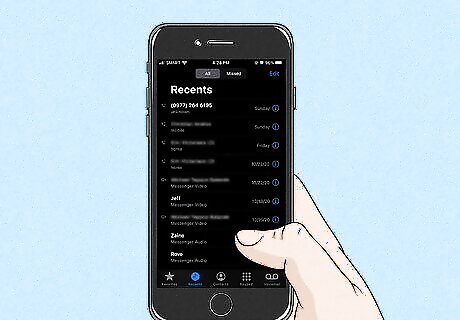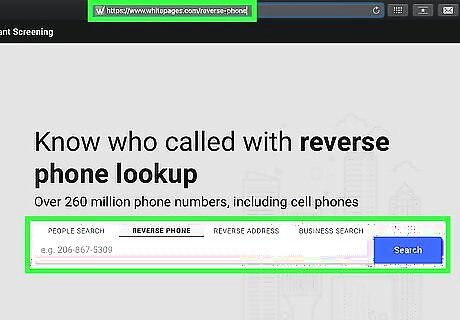
views
Finding an Unknown or Blocked Number

Check your call log or caller ID. All mobile phones will automatically identify most incoming phone calls. If you're on a land line (home phone), contact your phone provider to enable caller ID. Consult your phone manual or contact the manufacturer if you don't know how to check the call log for recent incoming phone numbers on your mobile phone. There are ways to bypass caller ID or even trick it into displaying the wrong number. If caller ID is unsuccessful, move on to the following options. If you're being harassed or threatened and fear for your safety, contact your local authorities to request assistance. Most locations have specific procedures to follow for tracing dangerous callers.

Ask for "call return" service. If you'd like to be able to return a call to an unknown number, ask your provider for the call return code or search the internet for "call return code for [your country]". Contact your phone provider and purchase "call return" or "last call return" service if necessary, as an initial fee may be required. The call return code varies depending on country and phone provider (and may not be available in all regions). In the United States, this service is also called *69 (after the code used in that country). After the call you want to trace has ended, enter the call return code and you should hear a voice message reading the telephone number of that caller, with the option to return the call. In some regions (such as California), call return will only return the last incoming call without telling you the phone number.

Enable "call trap" or "call trace" functions. If you are receiving repeated harassment calls from an unknown number, contact your phone provider and ask if these services are available: Call trap: After requesting a call trap, write down the dates and times you receive harassing phone calls for the next couple weeks (or for as long as your provider requests). Once you report this information to the phone company they will identify the harassing number and report it to law enforcement. Call trace: Once this service is enabled, pressing the call trace code immediately following the harassing call will send the phone number to law enforcement. (This code is *57 in the United States; your provider should tell you which code to use if you are in a different country.) Call traps are usually free, while call traces may cost an additional charge. If call trap is not available, or if the harassment is severe, you may be able to convince your phone provider to give you free call trace service.
Searching for a Phone Number

Type the number into a search engine. If you're not having any luck with the reverse-lookup sites, you can use Google, Bing, or any other search engine to run a search. Since search engines let you look through all kinds of data, you may find hints that can point you in the right direction. For example, if a phone number is associated with a business or website, the business or site's info will come up. Try formatting the number in different ways, such as XXX-XXX-XXXX or (XXX) XXXXXXX. You should also try placing the entire phone number in quotation marks and no other symbols (e.g., "XXXXXXXXXX")

Try a reverse-lookup database. There are many free websites that can provide basic information about a phone number. If the phone number you're tracing is a landline (not a mobile phone) and not private, you may be able to find the caller's name, business name, and/or address on a reverse-lookup site. If you search for a private landline or a mobile phone number, these websites will at least tell you the phone number's location and service provider. If you are prompted to pay for an upgrade see more detailed results, skip that—there are more free options to try. Whitepages (USA) Zabasearch (USA) Canada411 (CA) 411.ca (CA) WhoCallsMe (EU) ReverseAustralia (AUS) Although some reverse-lookup sites advertise paid services, they often won't yield results you couldn't find for free. Some sites are notorious for scamming customers, either by failing to provide any useful information for their money or by willfully stealing the customer's credit card information. If you do decide to use a paid service, research the company thoroughly, and stick to services that use PayPal or other well-known third-party systems.

Search for the number on Facebook or other social networking sites. Depending on the social network, you may be able to search for a phone number to find the owner's profile on that site. For example, if the owner of the phone number linked it to a Facebook account, you can search for the phone number using Facebook's regular search bar. If you suspect it is someone you have dealings with online, search the site where you exchange chat or information with them, such as on the site's forums.

Call the number. Explain to whoever answers that you've been receiving calls from the number. Politely ask who they are. If they tell you, no need to continue! If they don't, try one of the methods below. Try calling from an alternate number, such as a friend's phone, a Google Voice phone number, or a payphone. If you have called repeatedly and gotten no answer, it's possible that the other party is choosing not to pick up your calls. Calling from a friend's phone or a payphone can help rule out this possibility. If the person who answers claims to have not called your number, it's possible that a scammer used rogue software to disguise their phone number as someone else's. This phenomenon is called "spoofing," and often these numbers appear to come from your own area code.













Comments
0 comment